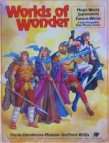Worlds of Wonder (game)
 Worlds of Wonder box cover | |
| Designer(s) | Steve Perrin, Steve Henderson (game designer), Gordon Monson, Greg Stafford, Lynn Willis |
|---|---|
| Publisher(s) | Chaosium |
| Publication date | 1982 |
| Genre(s) | Multi-genre |
| System(s) | Basic Role-Playing |
Worlds of Wonder is a 1982 multi-genre role-playing game publication produced by Chaosium. It is a boxed set consisting of four 16-page booklets: Basic Role-Playing, Magic World, Superworld, and Future World, an even shorter pamphlet on joining the settings together, a sheet of cardboard figures for each setting, and dice. The authors on the box are credited as Perrin (Steve Perrin), Henderson (Steve Henderson), Monson (Gordon Monson), Stafford (Greg Stafford), and Willin (Lynn Willis).
Multi-genre
Chaosium's Basic Roleplaying (BRP) rules, released in 1980, are considered the first commercial generic roleplaying system. Worlds of Wonder added rules for multi-genre support to cover similar ground as the Hero System used in the 1981 superhero game Champions and later products released by Hero Games. The idea, as stated in the pamphlet, was that characters could be created in any of the three settings, or even Basic Role-Playing, then physically travel to any of the three adventuring settings. The pamphlet proposed a neutral area that had magic connections to each of the worlds. Money from each setting would be valuable in the crossroads, at various conversion rates, and characters would be able to physically travel from one world to another.
Each setting booklet, however, was effectively a game in itself, with different (though mostly compatible) character generation and rules.
Magic World
The Magic World booklet contains generic fantasy game rules, untied to the Glorantha setting of RuneQuest and with a character class-based structure similar to Dungeons & Dragons. Character abilities are based on individual skills and percentages, and initial characters can start as one of 4 professions. Warriors start with more fighting skills, Rogues with adventuring skills, like stealth, Sages with non-combat knowledge skills, and only Sorcerers are permitted magic spell casting. Only Characters could also be members of the standard Tolkienesque fantasy races, such as dwarfs, trolls, goblins, and elves.
Casting spells in Magic World is a skill, and Sorcerers must succeed with their skill roll in order to cast it. This system was later incorporated into RuneQuest with its third edition.
Magic World is also the basis of the first version of the Swedish role-playing game, Drakar och Demoner (Dragons and Demons).[1] The name was reused for another BRP generic fantasy game released in 2013, but that game draws more on the discontinued Stormbringer than the rulebook in this set.[2]
Steve Perrin and Gordon Monson are credited as authors of this booklet.
Superworld
Superworld is a generic superhero game in a modern setting, in many ways similar to Champions. Superpowers are bought with Hero Points at character creation time. These points can also be spent to raise characteristics like strength or dexterity. Additional Hero Points can be gained by taking disabilities like blindness or vulnerability to certain attacks.
Steve Perrin and Steve Henderson are credited as authors of this booklet.
Superworld saw a later life as a standalone roleplaying game.
Future World
In the same way that the other two booklets took inspiration from other popular existing genre systems, Future World (or Future*World, as it is sometimes written in the game pages) was partly inspired by the then most popular science fiction role-playing game, Traveller. Like the Traveller background, Future World hypothesized a huge interstellar empire, and like its character generation rules, Future World characters started as members of one of six professions (Army, Civilian, Criminal, ICE, Scouts, or Science), and learned skills during terms of character generation.
Unlike Traveller, though, non-human characters were encouraged, and robots, and several alien races (ursinoids, insectoids, and saurians), were presented as character possibilities. Also unlike Traveller, travel between planets was by means of interstellar teleporter gates, maintained by ICE, the Imperial Corps of Engineers, not starships, changing play dynamics considerably. Rather than wandering the galaxy in their own spaceship, player characters would presumably be government or corporation associated explorers.
Reception
William A. Barton reviewed Worlds of Wonder in The Space Gamer No. 51.[3] Barton commented that "Overall, though its component parts may not be earth-shattering or overly innovative, Worlds of Wonder is still a pretty good buy."[3]
References
- ↑
- ↑
- 1 2 Barton, William A. (May 1982). "Featured Review: Worlds of Wonder". The Space Gamer. Steve Jackson Games (51): 4–5.